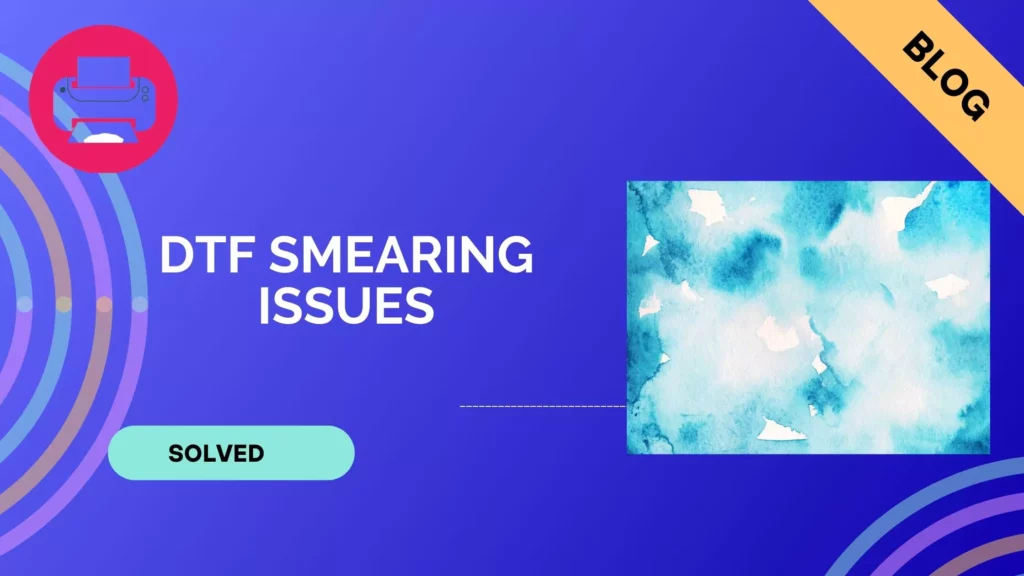Are you looking for the solutions of DTF film smearing issues? Everything was going well until I had an issue with some Calca A4 double matte transfer film sheets and my ET-8500. They began to curl, which interfered with printing. I even tried asking for assistance and changing the settings, but no luck. Together, let’s explore the charm of DTF printing and discover some of the recommended DTF smearing tips.

The Problem Explained
My ET-8500 has been printing DTF files without any problems, so everything was going well until this recent batch of Calca A4 double matte transfer film sheets appeared. I noticed that these sheets had an odd curl on both ends. tried to solve it by changing the density, printing on thick paper, and even tinkering with the little levers on the printhead.
Here’s the dilemma: If I raise the printhead too high, the colours lose their vibrancy and the print becomes hazy. Conversely, every damn time I keep it down, I get this obnoxious smear party in two distinct places.
So, I was completely clueless on what should be my approach to resolve it. But after doing some basic tweaks, I was able to fix the smearing issues successfully, though it took bunch of my time. Let’s dive to the solutions fast.
Solutions
Now, let me to explain some skillful moves that helped me overcome that persistent curling issue and win the game:
- Curing Oven Magic: A brief 45-second exposure in the curing oven is the recipe’s secret ingredient. Insert the film, let it to absorb the heat, and then remove it to allow it to cool. Like a little spa day for your transfer film. Your prints turn out smooth as butter after this magic straightens out those curls.
- Flat is Where It’s At: Yes, the sheets are often created by performing the curl tango on a film roll. The catch is that you need to make sure the sheets are as flat as a pancake before printing. Simply place them in the curing oven, and the issue will be resolved. Flat sheets mean happy prints.
- Vacuum Holes to the Rescue: Now, don’t worry if you’re using a wide-format printer without star wheels. The DTF conversion gurus are familiar with the process; those printers have vacuum holes in them. These little champs kick in to keep the substrate (that’s your film, in our lingo) dead flat. No more wicked curls creating trouble – just pure, flat goodness for your prints. It’s like having a hidden weapon against the curl brigade.
Try these tips, and you’ll see your prints take centre stage and the curling drama go away.
Tips for Preventing DTF Smearing
These are some reliable tips from the DTF printing trenches on how to control the beast – that is DTF smearing:
Optimize Printer Settings:
- Adjust temperature and speed settings with accuracy.
- Make that the printhead is calibrated and aligned precisely.
Select the Appropriate Substrates:
- Consider substrate compatibility for DTF printing.
- Carry out comprehensive experiments to verify compatibility with various substrates.
Ink Selection and Compatibility:
- Invest in premium DTF inks for best outcomes.
- Verify again that the ink and substrate are compatible to prevent spreading.
Environmental Elements:
- Regulate the temperature and humidity in the space where you print.
- Use safe handling and storage procedures for inks and substrates.
Flat is Fabulous: Before printing, flatten the film in a curing oven for around 45 seconds if you are having curling problems.
Vacuum Holes for Wide-Format Printers: In the event that your printer is not equipped with star wheels, use vacuum holes to keep the substrate flat.
Frequent Maintenance Schedule: Regular maintenance will keep your printhead in excellent condition.
Eliminate any obstructions or jams right once to avoid smearing problems.
Try New Things and Learn: Try experimenting with various parameters without fear. Take what you can from actual user experiences and modify your strategy appropriately.
Communication with Suppliers: Speak with your film and ink providers for advice on how to deal with smearing problems. Work together with manufacturers to diagnose issues and identify workable fixes.
Keep Up with Technological Developments:
- Pay attention to new developments in DTF printing technology.
- Adopt the most recent best practices for ongoing development.
By incorporating these suggestions into your DTF printing process, you’ll be equipped and prepared to combat smearing issues and guarantee that your prints turn out perfectly clear, colourful, and sharp. Cheers to your printing endeavours!
Conclusion
It takes a sharp eye for detail and a toolkit of useful techniques to become proficient in DTF printing. As we conclude off our journey through smearing solutions, remember: accuracy is your ally.
Tackle curling with the curing oven method, accept flatness, and utilise hoover holes. Adjust settings as needed, use premium inks, and take good care of your equipment.
Remain flexible, interact with vendors, and keep an eye out for new technological developments. Armed with these recommendations, your DTF prints will not only resist smearing but stand as testaments to your expertise in the bright realm of direct-to-film printing. Onward to flawless creations!
FAQs
Smearing can result from factors like incorrect temperature settings, substrate issues, or printhead misalignment.
Yes, a brief stint in the curing oven, around 45 seconds, can help flatten curled DTF film, improving print quality.
Yes, wide-format printers lacking star wheels can benefit from vacuum holes to maintain substrate flatness and prevent smearing.
Regular maintenance is crucial. Clear printhead clogs promptly and establish a routine to keep your printer in optimal condition.
Check substrate and ink compatibility, explore different curing times, and ensure the substrate is flat before printing.
While results may vary, it’s advisable to use an oven calibrated to around 45 seconds for consistent and effective flattening.
Optimize temperature and humidity in your printing environment, and ensure proper storage and handling practices for inks.
Yes, DTF film sheets often exhibit curling when sourced from a roll. Flattening techniques, like the curing oven trick, can address this issue.
While retrofitting vacuum holes may be challenging, consulting with experienced technicians or considering a DTF conversion could be explored.
Keep a lookout for industry publications, attend workshops, and engage with online forums to stay abreast of technological advancements in DTF printing.

Ashley Wang is a skilled sales manager with knowledge in DTF printing. She presently works for ShenLan Digital, a reputable DTF printer maker. Ashley is the best person to offer advice on selecting the most suitable DTF printer because she has tested a lot of them. She launched DTFPrinterSchool to educate individuals and organizations about DTF printing technology, providing her expertise and observations on the most recent advancements in the sector. Ashley is an invaluable resource for businesses and individuals wishing to invest in DTF printing technology because of her expertise and experience in the industry.
